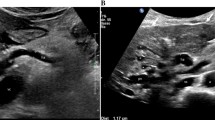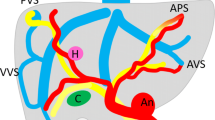Abstract
Hepatic arteriovenous malformations (HAVMs) in hereditary hemorrhagic telangiectasia (HHT) have long been considered to have scarce clinical significance in most cases. Nevertheless, data are lacking regarding the influence of HAVMs on the liver first-pass effect on drugs in HHT patients. To gain insight into the effect of HAVMs on hepatic drug clearance by means of two specific 13C-labeled probes, namely the 13C-methacetin and 13C-aminopyrine, 46 HHT patients and 44-matched healthy controls were enrolled. The liver first-pass effect was studied by the 13C-based breath test using methacetin and aminopyrine. The methacetin breath test showed statistically significant reduced metabolism rates (p < 0.0001) in HHT when compared with controls, both in patients with and without CT-detectable HAVMs, and when expressed both as cumulative 13C-percentage dose per hour and as 13C-percentage peak after 15 min. In contrast, no significant difference was found between HHT and controls regarding aminopyrin metabolism rates. In HHT, 13C%-methacetin breath test values are significantly lower than those found in normal subjects, probably due to the effect of hepatic shunts. A reduced perfusion and an impaired hepatic metabolism might affect hepatic drug clearance in HHT. Therefore, an appropriate dosage adjustments should be considered when high-hepatic-metabolism drugs are administered to HHT patients.


Similar content being viewed by others
Abbreviations
- HHT:
-
Hereditary hemorrhagic telangiectasia
- HAVMs:
-
Hepatic arteriovenous malformations
- 13C-%P15:
-
Percentage 13CO2 peak value after 15 min
- 13C-%CPH:
-
Percentage 13CO2 cumulative dose per hour data
References
Govani FS, Shovlin CL (2009) Hereditary hemorrhagic telangiectasia: a clinical and scientific review. Eur J Hum Genet 17:860–871
Faughnan ME, Palda VA, Garcia-Tsao G, et al (2009) International guidelines for the diagnosis and management of hereditary hemorrhagic telangiectasia. J Med Genet. doi:10.1136/jmg.2009.069013
Guttmacher AE, Marchuk DA, White RI Jr (1995) Hereditary hemorrhagic telangiectasia. N Engl J Med 333:918–924
Prigoda NL, Savas S, Abdalla SA et al (2006) Hereditary haemorrhagic telangiectasia: mutation detection, test sensitivity and novel mutations. J Med Genet 43:722–728
Lenato GM, Lastella P, Di Giacomo MC et al (2006) DHPLC-based mutation analysis of ENG and ALK-1 genes in the HHT Italian population. Hum Mutat 27:213–214
Sabba C, Gallitelli M, Pasculli G et al (2006) HHT: a rare disease with a broad spectrum of clinical aspects. Curr Pharm Des 12:1217–1220
Sabba C, Pasculli G, Lenato GM et al (2007) Hereditary hemorrhagic telangiectasia: clinical features in ENG and ALK1 mutation carriers. J Thromb Haemost 5:1149–1157
Gincul R, Lesca G, Gelas-Dore B et al (2008) Evaluation of previously non-screened hereditary hemorrhagic telangiectasia patients shows frequent liver involvement and early cardiac consequences. Hepatology 48:1570–1576
Garcia-Tsao G, Korzenik JR, Young L et al (2000) Liver disease in patients with hereditary hemorrhagic telangiectasia. N Engl J Med 28:931–936
Buscarini E, Plauchu H, Garcia Tsao G (2006) Liver involvement in hereditary hemorrhagic telangiectasia: consensus recommendations. Liver Int 26:1040–1046
Ianora AA, Memeo M, Sabba C et al (2004) Hereditary hemorrhagic telangiectasia: multi-detector row helical CT assessment of hepatic involvement. Radiology 230:250–259
Buonamico P, Suppressa P, Lenato GM et al (2008) Liver involvement in a large cohort of patients with hereditary hemorrhagic telangectasia: echo-color Doppler versus multislice CT study. J Hepatol 48:811–820
Verbeeck RK (2008) Pharmacokinetics and dosage adjustment in patients with hepatic dysfunction. Eur J Clin Pharmacol 64:1147–1161
Armuzzi A, Candelli M, Zocco MA et al (2002) Review article: breath testing for human liver function assessment. Aliment Pharmacol Ther 16:1977–1996
Streetman DS, Bertino JS Jr, Nafziger AN (2000) Phenotyping of drug metabolizing enzymes in adults: a review of in vivo cytochrome P450 phenotyping probes. Pharmacogenetics 10:187–216
Rivory LP, Slaviero KA, Hoskins JM et al (2001) The erythromycin breath test for the prediction of drug clearance. Clin Pharmacokinet 40:151–158
Vaira D, Gatta L, Ricci C et al (2010) A comparison amongst three rapid urease tests to diagnose Helicobacter pylori infection in 375 consecutive dyspeptic. Intern Emerg Med 5:41–47
Degre D, Bourgeois N, Boon N et al (2004) Aminopyrine breath test compared to the MELD and Child-Pugh scores for predicting mortality among cirrhotic patients awaiting liver transplantation. Transpl Int 17:31–38
Di Campli C, Angelini G, Armuzzi A et al (2003) Quantitative evaluation of liver function by the methionine and aminopyrine breath tests in the early stages of liver transplantation. Eur J Gastroenterol Hepatol 15:727–732
Braden B, Faust D, Sarrazin U et al (2005) 13C-methacetin breath test as liver function test in patients with chronic hepatitis C virus infection. Aliment PharmacolTher 21:179–185
Brockmöller J, Roots I (1994) Assessment of liver metabolic function: clinical implications. Clin Pharmacokinet 27:216–248
Baron A, Gulberg V, Sauter G et al (1998) Effects of transjugular intrahepatic portosystemic shunt (TIPS) on quantitative liver function tests. Hepatogastroenterology 45:2315–2321
Fimognari LF, Violi F (2008) Portal vein thrombosis in liver cirrhosis. Intern Emerg Med 3:213–218
Shovlin CL, Guttmacher AE, Buscarini E et al (2000) Diagnostic criteria for hereditary hemorrhagic telangiectasia (Rendu-Osler-Weber syndrome). Am J Med Genet 91:66–67
Wu JS, Saluja S, Garcia-Tsao G et al (2006) Liver involvement in hereditary hemorrhagic telangiectasia: CT and clinical findings do not correlate in symptomatic patients. AJR Am J Roentgenol 187:399–405
Buscarini E, Danesino C, Olivieri C (2004) Doppler ultrasonography grading of hepatic malformations of hereditary haemorrhagic telangiectasia. Ultraschall Med 25:348–355
Milot L, Kamaoui I, Gautier G et al (2008) Hereditary-hemorrhagic telangiectasia: one-step magnetic resonance examination in evaluation of liver involvement. Gastroenterol Clin Biol 32:677–685
Garcia-Tsao G, Swanson K (2008) Hepatic vascular malformations in hereditary hemorrhagic telangiectasia: in search for predictors of significant disease. Hepatology 48:1377–1379
Sawabe M, Arai T, Esaki Y et al (2001) Three-dimensional organization of the hepatic microvasculature in hereditary hemorrhagic telangiectasia. Arch Pathol Lab Med 125:1219–1223
Ciccocioppo R, Candelli M, Di Francesco D et al (2003) Study of liver function in healthy elderly subjects using the 13C-methacetin breath test. Aliment Pharmacol Ther 17:271–277
Lankisch TO, Schulz C, Zwingers T et al (2008) Gilbert’s syndrome and Irinotecan toxicity: combination with UDP-glucuronosyl transferase 1A7 variants increases risk. Cancer Epidemiol Biomarkers Prev 17:695–701
Mouly S, Rizzo-Padoin N, Simoneau G et al (2006) Effect of widely used combinations of antiretroviral therapy on liver CYP3A4 activity in HIV-infected patients. Br J Clin Pharmacol 62:200–209
Cakaloglu Y, Tredger JM, Devlin J et al (1994) Importance of cytochrome P-450IIIA activity in determining dosage and blood levels of FK 506 and cyclosporine in liver transplant recipients. Hepatology 20:309–316
Ghosh K, Ghosh K (2008) Hereditary haemorrhagic telangiectasia (HHT): negotiating between the Scylla of bleeding and Charybdis of thrombosis. Thromb Haemost 100:162–164
Gillum LA, Mamidipudi SK, Johnston SC (2000) Ischemic stroke risk with oral contraceptives: a meta-analysis. JAMA 284:72–78
Shovlin CL, Sulaiman NL, Govani FS et al (2007) Elevated Factor VIII in hereditary hemorrhagic telangiectasia: association with venous thromboembolism. Thromb Haemost 98:1031–1039
Borges NC, Barrientos Astigarraga R, Sverdloffa CE et al (2009) A novel and sensitive method for ethinylestradiol quantification in human plasma by high-performance liquid chromatography coupled to atmospheric pressure photoionization (APPI) tandem mass spectrometry: application to a comparative pharmacokinetics study. J Chromatogr B 877:3601–3609
Albiñana V, Bernabeu-Herrero ME, Zarrabeitia R et al (2010) Estrogen therapy for hereditary haemorrhagic telangiectasia (HHT): effects of raloxifene on Endoglin and ALK1 expression in endothelial cell. Thromb Haemost 103:525–534
Kemp DC, Fan PW, Stevens JC (2002) Characterization of Raloxifene glucuronidation: contribution of intestinal metabolism to presystemic clearance. Drug Metab Disp 30:694–700
Matsuo M, Kanematsu M, Kato H et al (2001) Osler-Weber-Rendu disease: visualizing portovenous shunting with three-dimensional sonography. AJR Am J Roentgenol 176:919–920
Acknowledgments
This study was funded in part by Italian Ministry of University and Technology (MIUR, project PRIN2004065303_002) and by Fondazione CARIME.
Conflict of interest
None.
Author information
Authors and Affiliations
Corresponding author
Rights and permissions
About this article
Cite this article
Candelli, M., Pompili, M., Suppressa, P. et al. Liver involvement in hereditary hemorrhagic telangiectasia: can breath test unmask impaired hepatic first-pass effect?. Intern Emerg Med 7, 323–329 (2012). https://doi.org/10.1007/s11739-011-0531-9
Received:
Accepted:
Published:
Issue Date:
DOI: https://doi.org/10.1007/s11739-011-0531-9




